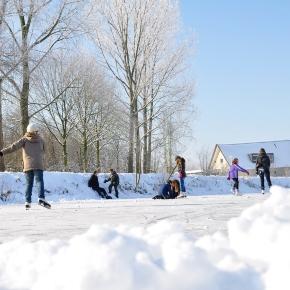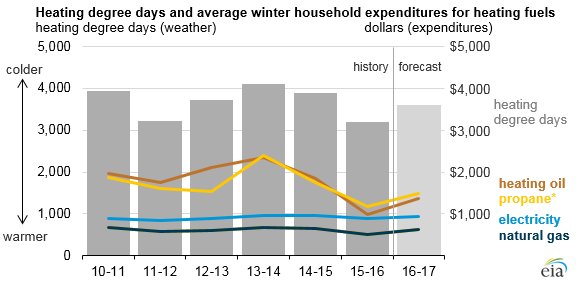Yesterday, #Government analysts at the Department of Energy said to expect higher heating bills this winter, even if it’s natural gas, heating oil, propane, or electricity. That’s based on a likely colder winter and higher costs for fossil fuel power. The winter of 2015- 2016 was notable as having above-normal temperatures arising from a strong, naturally occurring El Nino. An El Nino occurs when the tropical Pacific Ocean shows higher-than-normal temps for at least three consecutive months.
The DOE notes the demand for heating fuels last winter was the lowest level in 25 years. That translated into the United States emitting far less carbon dioxide emissions, the greenhouse gas blamed for any perceived increases in temperatures. NOAA says that this winter will be cold due to a La Nina developing, where the tropical Pacific Ocean has lower-than-normal temps. This means colder winters for the Northern Hemisphere. Yesterday, NOAA wrote there was a “70 percent chance a La Nina will develop this fall.”
La Nina’s role
NOAA doesn’t expect the La Nina to be as strong as in previous years and is only 55 percent confident a La Nina event will persist long enough to be classified as a full-blown event. NOAA admits the “greater cooling in the tropical Pacific forecasted in the spring and summer by computer models didn’t occur.” If the computer models for a weaker La Nina are wrong, heating bills could likely soar. If the La Nina forecasts turn out to be overly robust, expect U.S. weather and overall climate to be impacted more heavily.
Is there a Weather $VIX? 5 of Boston’s snowiest winters on record (since 1800s) were in the last 10 years http://stks.co/c1hs4
More snow and colder temperatures would be good #News for skiers and winter sports enthusiasts. Last year saw cold temperatures, but very little precipitation due to the lack of excessive water vapor in the air. Many may recall #Climate Change experts pointing to increased snowfall as further proof of global warming. At least that’s what they said when the Northeast had its snowiest winter in 2014-2015. But when the cold and snow failed to appear last winter, many fell back on earlier claims that snow was a “thing of the past.”
#Climate experts like Leo DiCaprio say “snow
is a thing of the past” in Australia & NZ & ski resorts are broke
Calculating your heating bill
According to the DOE, the forecast for the average heating bill this winter (Oct to March) is natural gas will be up 22 percent nationally and 29 percent in the Northeast. If the winter is colder than forecasted, that bill would go up 31 percent and 38 percent respectively. That increase would affect about 50 percent of all homes currently heated by gas, the highest it’s been in six years. Because of a pipeline logjam, delivery of natural gas to the Northeast has been hampered. A new pipeline being brought online may help lower prices.
Winter heating bills likely to increase, but remain below recent winters http://go.usa.gov/xkypT #heatingoil #propane #natgas#electricity
And while heating oil accounts for only five percent of heating across the country, in the Northeast that number jumps to 25 percent. Heating oil has gone up roughly 42 cents a gallon because of higher crude prices, or 20 percent. For the 40 percent that heat by electricity, the good news is that it will be up by only five percent, thanks tofracking. Propane is expected to increase 21 percent. And if the winter forecast holds true, CO2 emissions will go up as people use more fossil fuels to stay warm.
The DOE says to use the percentage increases when budgeting for the new prices expected this winter.















